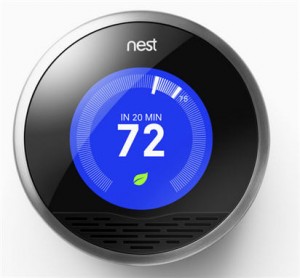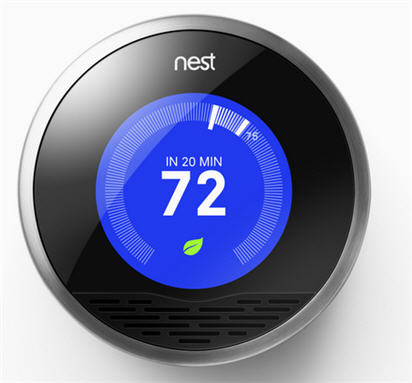Smart Technology: A Thermostat that Thinks
Scenario 1: When I was little, I shared a room with my older sister. Our bedroom was at the end of the hallway, and no matter how warm the rest of the house was, our room was always cold. My sister and I would crank up the thermostat to absurd levels, hoping that higher numbers would yield more heat and push some in the direction of our bedroom. Predictably, my dad would quickly reset the thermostat and lecture us on appropriate temperature levels for normal human beings. That thermostat taunted my sister and me with dreams of warmth and comfort, but delivered nothing. My sister and I were less than pleased.
Scenario 2: My roommate and I are compulsive about monitoring our monthly electricity bills. Con-Ed, the electricity company in New York, provides a great graph on each bill that shows how much energy a household consumes each month as compared to energy consumed that month exactly a year ago. You can see which months were responsible for robbing your piggy bank, and how they compare to last year’s bills . My roommate and I eagerly scrutinize this graph (we’re nerdy and we’re proud) and pat ourselves on the backs for outperforming our last “score” (i.e. energy consumed that month of the previous year).
Energy consumption, especially when you’re the one paying for it, can be a real pain. Coming home to find an air conditioning unit left on is literally painful. Facing the months of summer and the accompanying energy bills that make your jaw drop and your knees shake is an unwelcomed fate. Anything we can do to keep the bill to a minimum is well worth it. And that’s exactly what Nest, dubbed “The Learning Thermostat,” is intended to do.
Aside from its sleek and modern design (props to designer Tony Fadell, whose design portfolio includes the iPod, of all things), the Nest thermostat programs itself to automatically adjust based on your behavior. After “observing” your energy consumption patterns for a week, Nest is programmed to make all the temperature adjustments that suit your lifestyle. This automated technology helps cut down on your energy costs without you lifting a finger. As the website says, “Nest will remember to save, even if you forget.”


As Nest learns and “absorbs” your energy consumption behaviors, new features kick in. Auto-Away turns down heating and cooling when nobody is home; Energy History shows your energy consumption rates over time; a small leaf icon called Nest Leaf appears when you’re saving energy. The list goes on, with endlessly accessible features. Who knew a thermostat could do so much?
Nest is a great example of a product design team having a clear end-goal in mind. They didn’t call it quits once they had given the thermometer a facelift; they did a full body inside-and-out makeover, with us, the users, in mind. Nest takes the work out of being energy-conscious, and even remembers to turn off the air conditioning when nobody is home. What a perfect houseguest.
Nest Learning Thermostat Video
Update 1/14/2014: Google announces plans to buy Nest Labs for $3.2 billion.

Hmmm…We could still use one of those. That might be a nice $250 birthday present for someone..How many years until it earns its cost back?
That would be a nice $250 birthday present…the key word being $250 🙂
I’m not sure how long until it earns its cost back, but once the Nest is trained, your household is immediately more energy efficient. There are a bunch of ways that Nest helps you change your energy consumption behavior so you can actually see your actions making a difference. The Nest Leaf appears when your energy consumption is lower than normal, like a “Look who’s being energy efficient today!” congratulatory pat-on-the-back. Also, when you manually adjust the thermostat, the Nest indicates how long it takes to reach the desired temperature. This is to discourage people from making drastic temperature changes, which burns a lot of energy.
Wall Street Journal writer Katherine Boehret wrote a great review of this product and its utility: http://online.wsj.com/article/SB10001424052970204777904576653022627744048.html